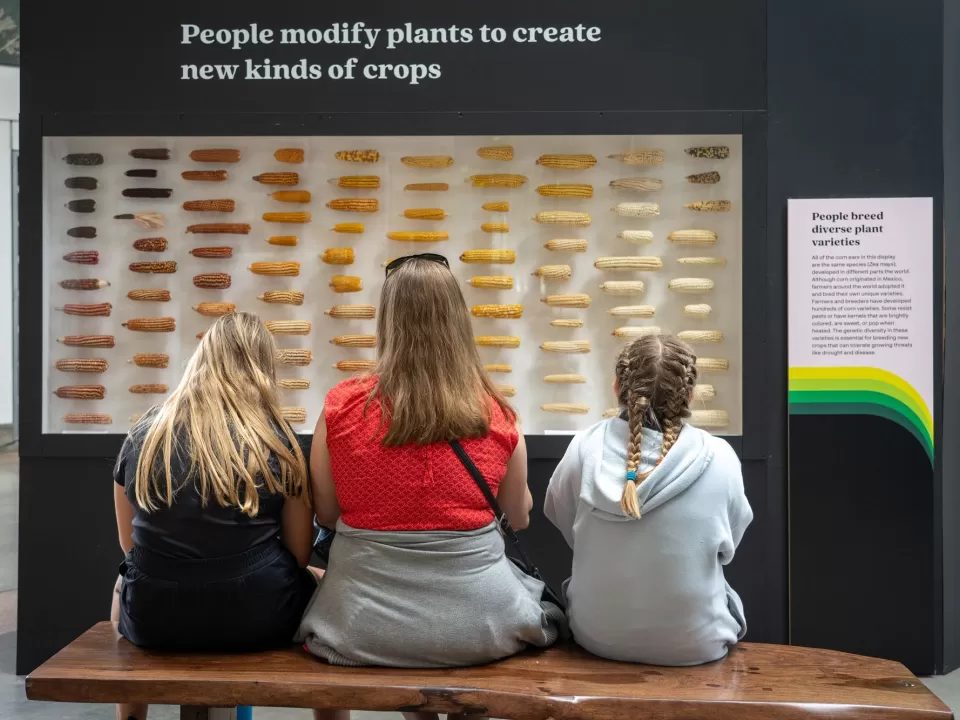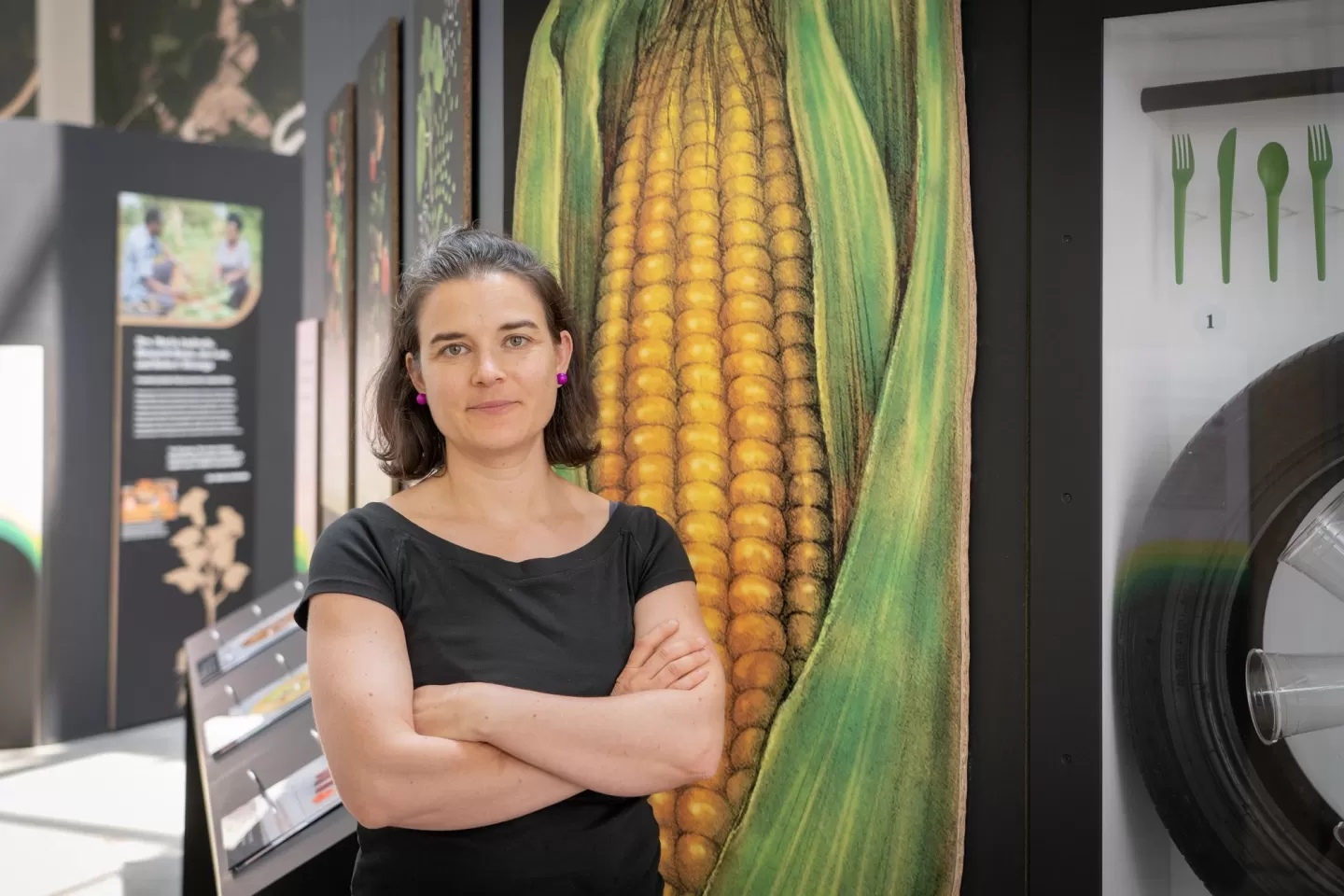A new exhibit at the U.S. Botanic Garden (USBG) celebrates agriculture across the country and around the world. "Cultivate: Growing Food in a Changing World" shares stories about agricultural science and innovation, about farmers, and about the way food connects people locally — and across the globe.
Visitors can see dozens of colorful varieties of corn and learn about the wild relatives of modern plants we eat, go hands-on to explore the science of agriculture through microscopes and hand lenses, dive into the stories of the many different peoples that have farmed North America through the centuries, and enjoy the smells of the plants that connect several local chefs with their food cultures as they share their stories in their own words.
The exhibit spreads across the USBG campus, with content in both exhibit galleries and stories throughout the Conservatory plus outdoor portions on the Terrace and in Bartholdi Gardens.



A visitor adds her message to the What Tastes Like Home? wall; Stories of local chefs and foods that connect them to their community shown through visuals, audio recordings and scents; Using microscopes and hand lenses to see agriculture's smaller side.
At its heart, the exhibit tells its stories of agriculture through features created by over 75 people and organizations from around the world, and through text and design steered by a multi-disciplinary core team, including employees from Learning and Engagement, Horticulture, Administration and the executive team. Most impressively, the entire exhibit was designed in-house by Theresa Dahlman, Visual Information Specialist.
Dahlman was perfectly poised to lead the exhibit design; her entire career has involved exhibits from installation at the National Portrait Gallery to graphic production and hands-on exhibit installation at Smithsonian's Office of Exhibits Central. She even has a master's degree in museum studies with concentration in exhibit design.
"It was a great advantage having an in-house exhibit designer," said Amy Bolton, the manager of the Learning and Engagement team. "Theresa has a history and knowledge of our spaces and how our visitors interact with the spaces, which was invaluable. There was no additional learning and catch-up required that an outside contractor would need, and it supported a collaborative exhibit development process where conversations happened naturally."
"Designing this exhibit was really a fun project, and it was a joy to get to dig in and create ways to tell the many great stories," Dahlman said. "One of the things I really enjoyed about working on this exhibit was researching sustainable agricultural plant-based building materials. Most of the exhibit was built from products left over after the harvest, like wheat shafts and sunflower hulls. There was a lot of support and excitement from the internal USBG teams about these materials and using them reinforces the agricultural products story in a great, surprising way."
The exhibit isn't just physically gardenwide, every team at the USBG helped with its development and installation. The Operations team built portions of the exhibit with reused lumber and display cases from a previous exhibit, and the Administration team helped with purchasing and contracts to secure plants and exhibit items from across the country in addition to helping administer myriad specialist contracts.

One of the 19 custom murals showcasing the origins of crops that were created for an outdoor portion of the exhibit.
Living plants help tell the story and better connect visitors to the origins of their food. The Horticulture team designed and planted an extraordinary outdoor display showing modern agricultural plants grouped by their region of origin from around the world.
The exhibit was more than two years in the making, with the original idea being chosen in 2019, then the core team working to bring it to life. The USBG was able to secure Sara Seiter and Emily Canosa, a team with experience in both agriculture and museum exhibit creation, to draft the visitor experience, research stories of agriculture from around the world, and develop the exhibit labels and text.



A display with dozens of varieties of corn grown by humans through the years; Visitors learn about legumes of the world through a tabletop display; Stories of multiple farmers are told in their own words through multi-screen videos.
"Working with Seiter and Canosa provided a unique opportunity for our visitors to hear from expert voices and individuals in agriculture from around the world," said Libby Rhoads, Learning and Engagement Supervisor. "With their help in gathering such a wide range of people and locations, this exhibit is able to tell the stories of people from around the world all in one place for our visitors to explore."
Dahlman's favorite aspects of the exhibit include the interactive elements like the weighted plates, which demonstrate the physical weight of foods' carbon footprints, and her work designing the corn display, which showcases dozens of variations humans have bred. "I also want to thank the experts over at the U.S. Department of Agriculture (USDA) for their help," Dahlman said. "So many helpful conversations with USDA helped me understand various agricultural concepts so that we could showcase them in a successful way."
IMAGE

Theresa Dahlman reviews an interactive element in the agriculture exhibit that gives physical weight to carbon dioxide created by different foods.
Now that the exhibit is open, Dahlman said a pleasant surprise is seeing how many people spend time writing thoughtful comments and even drawings to post on the wall in the What Tastes Like Home section. During the exhibit's first nine weeks, visitors have already posted around 10,000 notes sharing the foods that make them think of home.
The exhibit offered the opportunity to develop a new model for exhibit creation, which the team will use for exhibit development going forward.
"We started with what we want visitors to take away — by crafting the visitor goals and experiences," Bolton said. "Then we chose stories and wrote the script to fulfill that interpretive plan."
Every day USBG employees hear visitors' enthusiasm as they become immersed in the exhibit, exploring and interacting with its many elements.
"It's a whole-garden experience, filling exhibit spaces and horticulture spaces" Bolton said. "Being able to engage the entire USBG team from the beginning enabled it to be a collaborative experience where everyone could bring their expertise and it shows with an exhibit that is inviting, educational and fun."
"Cultivate: Growing Food in a Changing World" is on display through December 2023. Learn more about the exhibit and related programs at www.USBG.gov.
